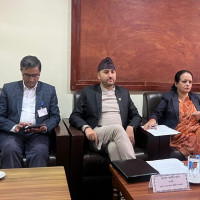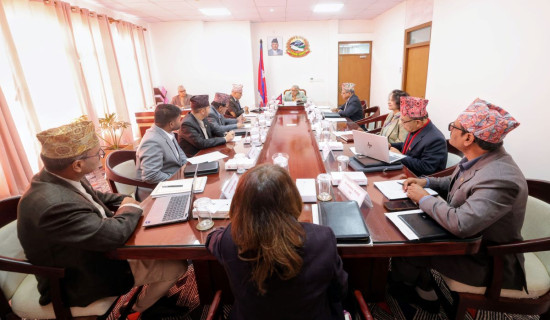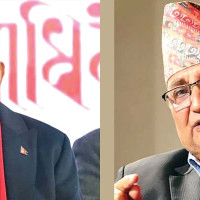- Tuesday, 16 December 2025
Bust Myths On Learning Disabilities
The results of the Google Search about learning disabilities in Nepal were copied and pasted (plagiarised text) as follows, which may be misleading or debatable, according to disability data from the 2022 Nepal census, "roughly 1.73 per cent of the population is categorised as having intellectual disabilities." Additionally, according to the same database, 1.94 per cent of people are disabled in some way. According to Nepal's 2011 Population Census, 2 per cent of the country's population was impaired. The 2022 Nepal Census states that around 2.2 per cent of people live with a disability. The prevalence of disability is higher in rural areas (89 per cent) than in urban areas (11 per cent). The government categorises disabilities into ten different types, including intellectual disabilities as against usual term learning disability”.
Learning disabilities (LDs) are often misunderstood, stigmatised, or overlooked in society, especially in developing economies. These are neurological conditions that affect how a person processes information, learns new skills, and communicates. Common types of learning disabilities include dyslexia (difficulty in reading), dyscalculia (difficulty in mathematics), and dysgraphia (difficulty in writing). They are not a reflection of a person’s intelligence or willpower, but rather a different way of processing information.
Myths
One of the greatest barriers for people with learning disabilities is the widespread myth that they are less capable or intelligent. Ignorance and a strict educational system that prioritises homogeneity over diversity are the root causes of this fallacy. Many people with learning disabilities are intelligent, imaginative, and gifted in their own special ways. Several historical personalities, including Agatha Christie, Leonardo da Vinci, and Albert Einstein, are thought to have suffered learning impairments. Their accomplishments highlight an important fact: learning differently does not equate to learning less.
People who do not meet conventional educational requirements are marginalised when society views academic achievement as a measure of intelligence. In addition to harming self-esteem, this can also deny the community access to the variety of skills and ideas these people have to offer. The first step in creating a society that is more inclusive and just is realising this. Students who study in a traditional, linear fashion are the target audience for the majority of curriculum. Teachers are overworked, exams are strict, and classrooms are frequently overcrowded. Personalised learning tactics, which are crucial for students with learning disabilities, are not given enough space.
Furthermore, there are rarely enough modules on inclusive practices or special education in teacher preparation programmes. Because of this, even teachers with the best of intentions may find it difficult to recognise or assist pupils who have learning problems. Children with learning disabilities may be further marginalised if they are mistakenly perceived as being inattentive, lazy, or disobedient. Both policy and practice need to be reformed. Policies for inclusive education that acknowledge and accommodate different learning requirements should be put into place in schools. This includes developing individualised education plans (IEPs), hiring special education teachers, and offering assistive technology. Additionally, standardised testing must be reexamined to make room for alternative evaluation techniques that more accurately represent a student's aptitudes.
The first indications of a learning problem frequently appear in the family. Parents may observe that their child has significantly greater difficulties than their peers in reading, writing, or basic math. Unfortunately, a lot of parents either reject the issue or feel ashamed because of social stigma and ignorance. Disabilities of any kind are stigmatised in some cultures because they are linked to moral failings or bad karma. It is important to let parents understand that learning difficulties are not their fault or a hindrance to their child's development.
A child's ability to adjust and thrive in school and life can be greatly impacted by early diagnosis and intervention. Parent-focused counseling and awareness initiatives are crucial. Family assistance is so essential to a child with a learning disability's growth and well-being. Resilience and confidence can be increased by promoting strengths, acknowledging minor accomplishments, and keeping lines of communication open. However, the stigma associated with learning difficulties has an impact on mental health as well as academic achievement. Children with learning disabilities frequently experience social rejection, bullying, and continual peer comparison. This can eventually result in feelings of worthlessness, worry, and melancholy.
Many individuals with learning difficulties have exceptional skills in narrative, design, music, art, and problem-solving. Their distinct thought processes can produce novel concepts and inventive fixes that others might miss. Society must abandon a deficit-focused perspective and embrace these assets. Employment and education must be inclusive. Schools need to provide spaces where learning diversity is accepted and valued. A supportive workplace atmosphere, reasonable adjustments, and inclusive hiring procedures should all be offered by employers.
Inclusive behaviour
By requiring inclusive behaviours, providing financing for special education programmes, and guaranteeing accessibility in public services, government policies should encourage these activities. Local municipalities can help with implementation and community outreach, while the Ministry of Education can take action to create national policies for inclusive education. Although learning disabilities are a permanent disease, people with them can live successful, independent lives if they receive the proper support. Empathy and awareness are the first steps on this quest.
Every action makes the world a more inclusive place, whether it is a teacher changing the way they teach, a parent asking for a child's evaluation, or a legislator providing funding for special education. To sum up, learning impairments are a unique method of experiencing and engaging with the world rather than a constraint. It is not too late to appreciate and acknowledge diversity in daily life as well as in philosophy. Let us pledge to create a future in which all students receive the respect, opportunity, and assistance they are due, irrespective of their preferred method of learning.
(Dr. Lohani is the executive director at the Health Concern. lohanis@gmail.com)

















